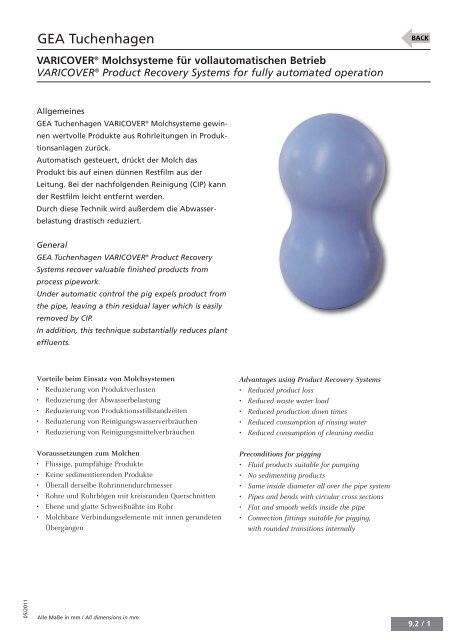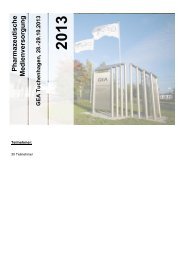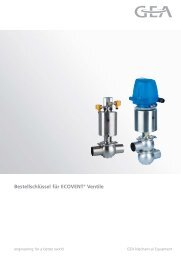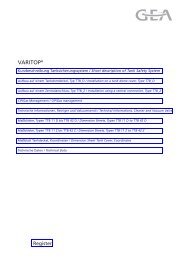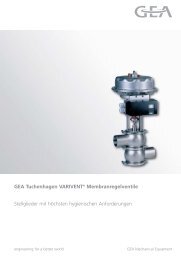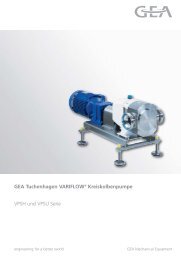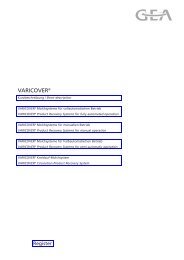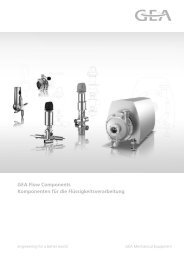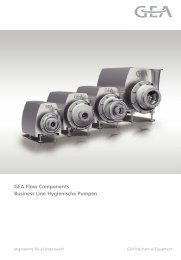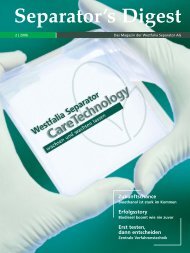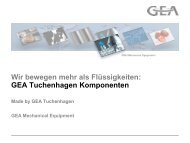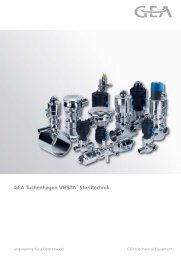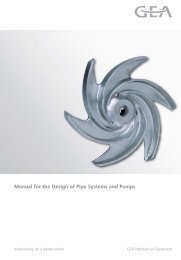VARICOVER Product Recovery Systems - GEA Tuchenhagen
VARICOVER Product Recovery Systems - GEA Tuchenhagen
VARICOVER Product Recovery Systems - GEA Tuchenhagen
Erfolgreiche ePaper selbst erstellen
Machen Sie aus Ihren PDF Publikationen ein blätterbares Flipbook mit unserer einzigartigen Google optimierten e-Paper Software.
<strong>GEA</strong> <strong>Tuchenhagen</strong><br />
<strong>VARICOVER</strong> ® Molchsysteme für vollautomatischen Betrieb<br />
<strong>VARICOVER</strong> ® <strong>Product</strong> <strong>Recovery</strong> <strong>Systems</strong> for fully automated operation<br />
Allgemeines<br />
<strong>GEA</strong> <strong>Tuchenhagen</strong> <strong>VARICOVER</strong> ® Molchsysteme gewinnen<br />
wertvolle Produkte aus Rohrleitungen in Produktionsanlagen<br />
zurück.<br />
Automatisch gesteuert, drückt der Molch das<br />
Produkt bis auf einen dünnen Restfilm aus der<br />
Leitung. Bei der nachfolgenden Reinigung (CIP) kann<br />
der Restfilm leicht entfernt werden.<br />
Durch diese Technik wird außerdem die Abwasser -<br />
belas tung drastisch reduziert.<br />
General<br />
<strong>GEA</strong> <strong>Tuchenhagen</strong> <strong>VARICOVER</strong> ® <strong>Product</strong> <strong>Recovery</strong><br />
<strong>Systems</strong> recover valuable finished products from<br />
process pipework.<br />
Under automatic control the pig expels product from<br />
the pipe, leaving a thin residual layer which is easily<br />
removed by CIP.<br />
In addition, this technique substantially reduces plant<br />
effluents.<br />
Vorteile beim Einsatz von Molchsystemen<br />
• Reduzierung von Produkt verlusten<br />
• Reduzierung der Abwasser belastung<br />
• Reduzierung von Produk tionsstillstand zeiten<br />
• Reduzierung von Reini gungswasserverbräuchen<br />
• Reduzierung von Reini gungsmittelverbräuchen<br />
Voraussetzungen zum Molchen<br />
• Flüssige, pumpfähige Produkte<br />
• Keine sedimentierenden Produkte<br />
• Überall derselbe Rohrinnendurchmesser<br />
• Rohre und Rohrbögen mit kreisrunden Querschnitten<br />
• Ebene und glatte Schweißnähte im Rohr<br />
• Molchbare Verbindungselemente mit innen gerundeten<br />
Übergängen<br />
Advantages using <strong>Product</strong> <strong>Recovery</strong> <strong>Systems</strong><br />
• Reduced product loss<br />
• Reduced waste water load<br />
• Reduced produc tion down times<br />
• Reduced consumption of rinsing water<br />
• Reduced consumption of cleaning media<br />
Preconditions for pigging<br />
• Fluid products suitable for pumping<br />
• No sedimenting products<br />
• Same inside diameter all over the pipe system<br />
• Pipes and bends with circular cross sections<br />
• Flat and smooth welds inside the pipe<br />
• Connection fittings suitable for pigging,<br />
with rounded transitions internally<br />
05/2011<br />
Alle Maße in mm / All dimensions in mm<br />
9.2 / 1
<strong>GEA</strong> <strong>Tuchenhagen</strong><br />
<strong>VARICOVER</strong> ® Molchsysteme für vollautomatischen Betrieb<br />
<strong>VARICOVER</strong> ® <strong>Product</strong> <strong>Recovery</strong> <strong>Systems</strong> for fully automated operation<br />
Merkmale der vollautomatischen <strong>GEA</strong> <strong>Tuchenhagen</strong><br />
<strong>VARICOVER</strong> ® Molchsysteme<br />
• Sicherer Betrieb durch geschlossene Rohrsysteme; keine<br />
Molchentnahme während des Betriebes erforderlich<br />
• Automatische Funktionsabläufe und damit voll validierbarer<br />
Prozess<br />
• Molchpositionserkennung über magnet-induktive Näherungsschalter<br />
– kurz "Magnetschalter"<br />
• Vollständige Restentleerbarkeit der Molchstationen<br />
durch totraumfreie Konstruktion<br />
• Vollständig CIP-/SIP-fähig<br />
• Parallele Reinigung der Molchtreibmedien-Zufuhrventile<br />
• Molchtreibmedium kann Wasser, Luft, CO 2 oder N 2 sein<br />
• Temperaturbeständigkeit bis 130 °C<br />
• Produktdruck max. 10 bar<br />
• Rohranschlüsse mit VARIVENT ® Flanschverbindungen<br />
• Produktberührte Teile aus Werkstoff 1.4404<br />
• Produktberührte Oberflächen Ra ≤ 1,2 µm/≤ 0,8 µm<br />
• Produktberührte Dichtungen aus EPDM oder FPM<br />
• Molche wahlweise aus Silikon oder FPM<br />
• Auch im Ex-Bereich einsetzbar<br />
Features of the fully automated <strong>GEA</strong> <strong>Tuchenhagen</strong><br />
<strong>VARICOVER</strong> ® <strong>Product</strong> <strong>Recovery</strong> <strong>Systems</strong><br />
• Safe operation due to closed pipe systems, no removal of<br />
the pig for operational purposes required<br />
• Fully automatic and thus verifiable processes<br />
• Position of the pig detected by using magnetic-inductive<br />
proximity switches - in short "magnetic switch"<br />
• Fully drainable pig stations due to their pocket-free design<br />
• Fully CIP-/SIP-able<br />
• Parallel cleaning of the pig driving media supply valves<br />
• The pig`s driving medium may be water, air, CO 2 or N 2<br />
• Temperature resistance up to 130 °C<br />
• <strong>Product</strong> pressure 10 bar max.<br />
• Pipe connections with VARIVENT ® flange connections<br />
• <strong>Product</strong> contacted parts<br />
made of material 1.4404 (AISI 316L)<br />
• <strong>Product</strong> contacted surfaces Ra ≤ 1.2 µm/≤ 0.8 µm<br />
• <strong>Product</strong> contacted seals made of EPDM or FPM<br />
• The pig is available in Silicone or FPM<br />
• As well applicable in explosion-proof area<br />
Baugrößen<br />
Rohrinnen-<br />
Baugröße durchmesser<br />
DN 25 26,0 mm<br />
DN 40 38,0 mm<br />
DN 50 50,0 mm<br />
DN 65 66,0 mm<br />
DN 80 81,0 mm<br />
DN 100 100,0 mm<br />
Sizes<br />
Pipe inside<br />
Size<br />
diameters<br />
1" OD 22.2 mm<br />
11/2" OD 34.9 mm<br />
2" OD 47.6 mm<br />
21/2" OD 60.3 mm<br />
3" OD 73.0 mm<br />
4" OD 97.6 mm<br />
Anwendungen<br />
Applications<br />
Produktausschub<br />
<strong>VARICOVER</strong> ® Molchsysteme sind überall dort einsetzbar,<br />
wo fließ fähige Produkte ohne Vermischung mit anderen<br />
Medien aus Rohrleitun gen ausgeschoben werden müssen.<br />
Diese Aufgabe stellt sich besonders bei hochwertigen Produkten<br />
und damit in der Lebens mittel- und in der Geträn ke -<br />
industrie ebenso wie in der Kosmetikindus trie und der<br />
pharmazeutischen Industrie.<br />
9.2 / 2<br />
<strong>Product</strong> push-outs<br />
<strong>VARICOVER</strong> ® <strong>Product</strong> <strong>Recovery</strong> <strong>Systems</strong> are used whenever<br />
viscous products must be expelled from pipe systems without<br />
the risk of intermixing with other media.<br />
This is especially required for high quality products in<br />
industries from food and beverages through to pharmaceuticals<br />
and cosmetics.<br />
Alle Maße in mm / All dimensions in mm<br />
05/2011
<strong>GEA</strong> <strong>Tuchenhagen</strong><br />
<strong>VARICOVER</strong> ® Molchsysteme für vollautomatischen Betrieb<br />
<strong>VARICOVER</strong> ® <strong>Product</strong> <strong>Recovery</strong> <strong>Systems</strong> for fully automated operation<br />
Anwendbar für Produkte wie:<br />
Shampoo, Lotion, Creme, Zahncreme<br />
Waschmittel, Weichspüler<br />
Joghurt, Quark, Käse<br />
Frucht, Saft, Teig, Pflanzenöl<br />
Saucen, Eiscreme, Konzentrate, Sirup<br />
Applicable for products as:<br />
Shampoo, Lotion, Cream, Tooth paste<br />
Washing agents, Softeners<br />
Yoghurt, Quark, Cheese<br />
Fruit, Juice, Dough, Vegetable oil<br />
Sauces, Ice cream, Concentrates, Syrup<br />
Der Molch<br />
Der Molch ist ein formstabiler Körper aus produktverträg -<br />
lichem, verschleiß festem und temperaturbeständigem<br />
Material. Seine Kontur ermöglicht eine sichere Reinigung<br />
der gesamten Oberfläche. Die Form des Molches gewährt<br />
ein optimales Durchfahren von engen und weiten Rohrbögen<br />
sowie T-Stücke mit reduzierter Aushalsung.<br />
Die Molchdetektierung erfolgt über magnet-induktive Näherungsschalter<br />
(Magnetschalter). Als Molchmaterialien sind<br />
FDA-konforme Werkstoffe aus Silikon oder FPM verfügbar.<br />
Die verfügbaren Molchtypen sind PK und<br />
DK.<br />
The Pig<br />
The pig is an inert flexible body made from wear and temperature<br />
resistant, product compatible material.<br />
Its contours allow safe clean ing of the entire surface; its<br />
shape ensures an optimal passage through small and large<br />
pipe bends as well as tees with a reduced collar.<br />
The position of the pig is detected via magnetic-inductive<br />
proximity switches (magnetic switch). Pigs are made from<br />
FDA-approved materials such as Silicone or FPM.<br />
Pigs are available in types PK and DK.<br />
PK:<br />
Material Silicone or FPM<br />
PK: Werkstoff Silikon oder FPM<br />
DK: Werkstoff Silikon<br />
Die im Inneren der Molche PK und<br />
DK befindlichen Permanentmagnete<br />
sind mit einer Edelstahlhülle gekapselt,<br />
so dass bei einer eventuellen<br />
Molchzerstörung kein Produkt mit<br />
dem Magnetwerkstoff in Kontakt<br />
kommen kann.<br />
DK: Material Silicone<br />
The permanent magnets inside the pigs<br />
PK and DK are encapsulated in a stainless<br />
steel enclosure so that no product<br />
gets into contact with the material of<br />
the magnet, even if the pig gets<br />
demaged.<br />
05/2011<br />
Molchreinigungs station<br />
Die Molchreini gungs station ist totraumfrei und vollständig<br />
CIP-/SIP-fähig ausgeführt. Sie ist In-line in den Produktweg<br />
eingebunden und kann flexibel als Sende- oder Empfangsstation<br />
eingesetzt werden. Der Molch ist in der Station<br />
während des Umströmens mit Produkt oder Reinigungs -<br />
medium lagefixiert. Die Strömungs rich tung durch die<br />
Sta tion ist beliebig und der Strömungs querschnitt um den<br />
Molch entspricht dem der Rohrleitung.<br />
Alle Maße in mm / All dimensions in mm<br />
Pig cleaning station<br />
The pocket-free design of the pig cleaning station is suitable<br />
for CIP and SIP. It is integrated in-line into the product path<br />
and can be used either as a launching or receiving station.<br />
<strong>Product</strong> or CIP solutions are transferred in either direction<br />
through the station past the pig which is firmly held within<br />
the unit. The cleaning station is designed so that the cross<br />
sectional area around the pig is the same as the pipework.<br />
9.2 / 3
<strong>GEA</strong> <strong>Tuchenhagen</strong><br />
<strong>VARICOVER</strong> ® Molchsysteme für vollautomatischen Betrieb<br />
<strong>VARICOVER</strong> ® <strong>Product</strong> <strong>Recovery</strong> <strong>Systems</strong> for fully automated operation<br />
weitere Merkmale sind:<br />
• Produkttransfer durch die Molchstation – mit oder ohne<br />
Molch in der Station<br />
• Permanenter Produktaustausch beim Umströmen des<br />
Molches in der Molchstation – keine nicht durchströmbaren<br />
Bereiche<br />
• Permanentes Überwachen der Molchposition über<br />
Magnetschalter von außen<br />
• Einfaches und sicheres Einsetzen und Entnehmen des<br />
Molches<br />
• Der Molchverschiebezylinder besteht aus einem<br />
Luft/Luft-gesteuerten Antrieb zur Beförderung des Molches<br />
in die Produktions-/ Reinigungsposition<br />
bzw. in die Sende-/ Empfangsposition<br />
• Die Molchhaltezylinder fixieren den Molch in der Station<br />
in ihrer federschließenden Ruhelage und geben den<br />
Molch in der pneumatisch angesteuerten Lage frei<br />
• Rohranschlüsse mit VARIVENT ® Flanschverbindungen<br />
Molchreinigungs station / Pig cleaning station<br />
additional features:<br />
• <strong>Product</strong> transfer through the pig station – with or without<br />
the pig positioned in the station<br />
• Full product flow when the product floods the pig in the<br />
station - no dead corners<br />
• Permanent monitoring of the pig position from the outside<br />
via magnetic switche<br />
• Easy and safe insertion and removal of the pig<br />
• The pig driving cylinder consists of an air/air controlled<br />
actuator used for moving the pig into the production/<br />
cleaning position resp. into the launching/ receiving position<br />
• The pig retention cylinders fix the pig in the station in<br />
their spring-closing, non-actuated position and release the<br />
pig in their pneumatic actuation position.<br />
• Pipe connections with VARIVENT ® flange connections<br />
Antrieb der Molchreinigungs station / Actuator of the pig cleaning<br />
station<br />
9.2 / 4<br />
Alle Maße in mm / All dimensions in mm<br />
05/2011
<strong>GEA</strong> <strong>Tuchenhagen</strong><br />
<strong>VARICOVER</strong> ® Molchsysteme für vollautomatischen Betrieb<br />
<strong>VARICOVER</strong> ® <strong>Product</strong> <strong>Recovery</strong> <strong>Systems</strong> for fully automated operation<br />
Molchfangstation<br />
Im Fangrohr wird der Molch mechanisch<br />
gestoppt. Der Molch kann dort nicht mit<br />
Reinigungsmedium umströmt werden.<br />
Wird die Molchfangstation als Molch -<br />
empfangsstation eingesetzt (Molchsystem<br />
EMI/1), muß der Molch diese unmittelbar<br />
nach seiner Ankunft wieder verlassen.<br />
Der im Fangrohr integrierte mechanische<br />
Molchanschlag wird im Zuge der Rohrreinigung<br />
vollständig gereinigt.<br />
Die Rohranschlüsse sind mit VARIVENT ®<br />
Flanschverbindungen ausgeführt.<br />
Molchfangstation / Pig catching station<br />
05/2011<br />
Molchstopper<br />
Der Molchstopper hat zwei Funktionen:<br />
1. Beim Einsatz des Molchfangrohres als Molchsendestation<br />
und Produkteinspeisung über ein Molch-T-Stück (Molchsystem<br />
EMII/1), verhindert der Molchstopper das Herausgleiten<br />
des Molches aus seiner Station bei eventuell auftretenden<br />
Vakuum.<br />
2. Durch den Einsatz von<br />
Molchstopper können<br />
Molche in Rohrleitungen<br />
vor bzw. hinter T-Ab gän -<br />
gen platziert werden.<br />
Molchstopper / Pig stopper<br />
Alle Maße in mm / All dimensions in mm<br />
Bei der federschließenden<br />
Molchstopperlage führt eine<br />
Stange durch den gesamten<br />
Rohrquerschnitt. Das Produkt<br />
wird durch den freien<br />
Querschnitt um die Stange<br />
herum gefördert, während<br />
der Molch den Molchstopper<br />
nicht passieren kann.<br />
Die pneumatisch angesteuerte<br />
Molchstopperlage gibt<br />
den Rohrweg für den Molch<br />
frei.<br />
Eingebaut wird der Molchstopper<br />
zwischen zwei<br />
VARIVENT ® Nutflansche.<br />
Pig catching station<br />
In the catching pipe where the pig is mechanically stopped,<br />
the pig will not be flooded with cleaning media.<br />
If the pig catching station is used as a pig receiving station,<br />
(<strong>Product</strong> <strong>Recovery</strong> System EMI/1) the pig must leave the<br />
station directly after its arrival.<br />
The mechanical pig stop which is integrated in the catching<br />
pipe is thoroughly cleaned during the pipe cleaning program.<br />
Pipe connections with VARIVENT ® flange connections.<br />
Pig stopper<br />
The pig stopper has two functions:<br />
1. Using the pig catching pipe as a pig launching station and<br />
product is supplied via a special Tee (<strong>Product</strong> <strong>Recovery</strong><br />
System EMII/1), the pig stopper prevents the pig from<br />
sliding out of the station in the case of vacuum build-up.<br />
2. The use of pig stoppers allows the location of pigs in pipes<br />
before or after Tee pieces.<br />
In the spring-closing position of the pig stopper, a rod travels<br />
over the entire pipe cross section. The product is conveyed<br />
into the area via the free cross section around the rod, while<br />
the pig remains captured by the pig stopper. On pneumatic<br />
actuation of the stopper the pig is released for further operations.<br />
The pig stopper is clamped between two VARIVENT ®<br />
grooved flanges.<br />
9.2 / 5
<strong>GEA</strong> <strong>Tuchenhagen</strong><br />
<strong>VARICOVER</strong> ® Molchsysteme für vollautomatischen Betrieb<br />
<strong>VARICOVER</strong> ® <strong>Product</strong> <strong>Recovery</strong> <strong>Systems</strong> for fully automated operation<br />
WK<br />
Molchfangstation / Pig catching station<br />
NL<br />
Molchtreibmediumventile<br />
Die Standard-Molchtreibmediumzufuhr-einheit<br />
besteht aus zwei kombinierte<br />
VARIVENT ® Ventile der Typen NL und<br />
WK, verbunden mit einem Molchfangrohr<br />
oder einem In-line Gehäuse.<br />
Das NL-Ventil dient als Absperrventil<br />
gegenüber der Produktleitung und das<br />
WK-Ventil als Wechselventil zwischen der<br />
Molchtreibmediumzufuhr am oberen<br />
Gehäuse und der Verbindung zum CIP-<br />
Rücklauf bzw. zur Entlüftung am unteren<br />
Stutzen.<br />
Durch diese Anordnung ist eine vollständige<br />
Reinigung des unteren Ventilstutzens<br />
des NL-Absperrventils sichergestellt.<br />
Die Nennweite der Ventile beträgt in<br />
Abhängigkeit des Treibmediums, der Rohrlänge<br />
und der Nennweite des<br />
Molchs DN 10, DN 15, DN 25 / 1" OD oder<br />
DN 40 / 11/2" OD.<br />
WK<br />
NL<br />
Pig driving medium valves<br />
The standard arrangement for the supply of<br />
the pig driving medium consists of two combined<br />
VARIVENT ® valves of the types NL<br />
and WK, which may be connected either to<br />
the pig catching pipe or to an in-line access<br />
unit.<br />
The NL valve is used for shut-off from the<br />
product pipe and the WK valve serves as a<br />
shuttle between the supply of the pig driving<br />
medium at the upper housing and the<br />
connection to the CIP return resp. as a vent<br />
at the lower socket. This arrangement allows<br />
for complete cleaning of the lower valve<br />
socket of the NL shut-off valve.<br />
The nominal width of the valves is DN 15, DN<br />
25 / 1" OD or DN 40 / 11/2" OD depending on<br />
the pig driving medium, the pipe lenght and<br />
the nominal diameter of the pig.<br />
Molchtreibmediumventile mit In-line-Gehäuse/ Pig driving medium valves with inline<br />
housing<br />
9.2 / 6<br />
Alle Maße in mm / All dimensions in mm<br />
05/2011
<strong>GEA</strong> <strong>Tuchenhagen</strong><br />
<strong>VARICOVER</strong> ® Molchsysteme für vollautomatischen Betrieb<br />
<strong>VARICOVER</strong> ® <strong>Product</strong> <strong>Recovery</strong> <strong>Systems</strong> for fully automated operation<br />
VARINLINE ® -Gehäuse<br />
Das In-line Gehäuse ermöglicht außer den Anschluß der<br />
Molchtreibmediumzufuhrventile zusätzlich die Adaption<br />
eines VARINLINE ® Manometers oder eines VARINLINE ®<br />
Drucktransmitters zur Aufzeichnung von Molchtreibdruckkurven<br />
während der Inbetriebnahme und des Betriebes.<br />
Die Rohranschlüsse sind mit VARIVENT ® Flanschverbindungen<br />
ausgeführt.<br />
VARINLINE ® access unit<br />
The in-line access unit allows - apart from the connection of<br />
the valves for the supply of the pig driving medium - the<br />
additional installation of a VARINLINE ® pressure gauge or a<br />
VARINLINE ® pressure transmitter provided for recording the<br />
pig driving pressure characteristics during commissioning<br />
and operation. For pipe connections VARIVENT ® flange<br />
connections are used.<br />
VARINLINE ® Gehäuse / VARINLINE ® access unit<br />
Molch-T-Stück<br />
T-Stücke in Molchleitungen dienen als Produkteintritt- bzw.<br />
–austrittkomponenten.<br />
Durch den um eine Nennweite kleiner ausgehalsten<br />
Abgangsstutzen ist eine ausreichende Molchführung im<br />
geraden Durchgang gewährleistet.<br />
Die Rohranschlüsse sind mit VARIVENT ® Flanschverbindungen<br />
ausgeführt.<br />
Special Tees<br />
Speccial Tees in pigging pipes are used as product inlet/outlet<br />
components.<br />
The branch-off socket which is reduced by one nominal<br />
width, ensures a straight passage of the pig.<br />
For pipe connections VARIVENT ® flange connections are<br />
used.<br />
Molch-T-Stück / Special Tee<br />
05/2011<br />
Alle Maße in mm / All dimensions in mm<br />
9.2 / 7
<strong>GEA</strong> <strong>Tuchenhagen</strong><br />
<strong>VARICOVER</strong> ® Molchsysteme für vollautomatischen Betrieb<br />
<strong>VARICOVER</strong> ® <strong>Product</strong> <strong>Recovery</strong> <strong>Systems</strong> for fully automated operation<br />
Standard <strong>VARICOVER</strong> ® Molchsysteme,<br />
vollautomatisch<br />
Molchsystem EMI/1<br />
Funktionsablauf<br />
Standard <strong>VARICOVER</strong> ® <strong>Product</strong> <strong>Recovery</strong><br />
<strong>Systems</strong>, fully automated<br />
<strong>Product</strong> <strong>Recovery</strong> System EMI/1<br />
Functional description<br />
Sendestation<br />
V3<br />
V2<br />
V1<br />
Molchtreibmedium<br />
Launching Station<br />
V3<br />
V2<br />
V1<br />
Pig driving<br />
medium<br />
GO<br />
1<br />
GO<br />
2<br />
Produkt<br />
CIP<br />
GO<br />
1<br />
GO<br />
2<br />
<strong>Product</strong><br />
CIP<br />
V4.1<br />
V4.2<br />
V4.1<br />
V4.2<br />
V6<br />
V7<br />
Molchtreibmedium<br />
V6<br />
V7<br />
Pig driving<br />
medium<br />
Produkt<br />
CIP<br />
<strong>Product</strong><br />
CIP<br />
GO<br />
3<br />
Empfangsstation<br />
GO<br />
3<br />
Receiving Station<br />
Produktion<br />
Der Molch befindet sich lagefixiert in der Sendestation<br />
und wird vom Produkt umströmt.<br />
Produktausschub<br />
Der Molch wird mittels eines Treibmediums durch die<br />
Rohrleitung gedrückt und schiebt das Restprodukt in<br />
Richtung der Empfangsstation aus.<br />
Molch zurück<br />
Nach Erreichen der Empfangsstation wird der Molch<br />
sofort zur Sendestation zurückgedrückt.<br />
Reinigung<br />
Die Reinigung der Molchstationen erfolgt im Zuge der<br />
Rohrreinigung. Der Molch wird hierbei in der Sendestation<br />
vollständig umspült und gereinigt.<br />
<strong>Product</strong>ion<br />
The pig is firmly held in position in the launching station<br />
and flooded with product.<br />
<strong>Product</strong> push-out<br />
The pig is pushed through the pipe by means of a driving<br />
medium and pushes the residual product towards the<br />
receiving station.<br />
Pig return<br />
When reaching the receiving station, the pig is immediately<br />
returned to the launching station.<br />
Cleaning<br />
The pig stations are cleaned together with the pipes<br />
during the pipe cleaning program. The pig is fully flooded<br />
in the launching station and cleaned.<br />
9.2 / 8<br />
Alle Maße in mm / All dimensions in mm<br />
05/2011
<strong>GEA</strong> <strong>Tuchenhagen</strong><br />
<strong>VARICOVER</strong> ® Molchsysteme für vollautomatischen Betrieb<br />
<strong>VARICOVER</strong> ® <strong>Product</strong> <strong>Recovery</strong> <strong>Systems</strong> for fully automated operation<br />
Molchsystem EMII/1<br />
Funktionsablauf<br />
<strong>Product</strong> <strong>Recovery</strong> System EMII/1<br />
Functional description<br />
Sendestation<br />
V5<br />
V6<br />
V7<br />
Molchtreibmedium<br />
Launching Station<br />
V5<br />
V6<br />
V7<br />
Pig driving<br />
medium<br />
CIP<br />
CIP<br />
Produkt<br />
CIP<br />
GO<br />
3<br />
<strong>Product</strong><br />
CIP<br />
GO<br />
3<br />
V4.1<br />
V4.2<br />
V2<br />
V1<br />
Molchtreibmedium<br />
V4.1<br />
V4.2<br />
V2<br />
V1<br />
Pig driving<br />
medium<br />
GO<br />
2<br />
GO<br />
2<br />
GO<br />
1<br />
Produkt<br />
CIP<br />
GO<br />
1<br />
<strong>Product</strong><br />
CIP<br />
V3<br />
Empfangsstation<br />
V3<br />
Receiving Station<br />
Produktion<br />
Der Molch befindet sich lagefixiert im Fangrohr der Sendestation<br />
und der Produkteintritt erfolgt über den seitlichen<br />
Stutzen des Molch-T-Stückes.<br />
Der Molchstopper V5 verhindert das Herausgleiten des<br />
Molches bei Vakuum in der Rohrleitung.<br />
Produktausschub<br />
Der Molch wird mittels eines Treibmediums durch die<br />
Rohrleitung gedrückt und schiebt das Restprodukt in<br />
Richtung der Empfangsstation aus. Der Molch bleibt für<br />
die anschließende Reinigung in der Empfangsstation.<br />
Reinigung<br />
Die Reinigung der Molchstationen erfolgt im Zuge der<br />
Rohrreinigung. Der Molch wird hierbei in der Empfangsstation<br />
vollständig umspült und gereinigt. Das System<br />
darf anschließend nicht mit Dampf sterilisiert werden,<br />
da der Molch nicht in einer trockenen Leitung zurückgedrückt<br />
werden kann.<br />
<strong>Product</strong>ion<br />
The pig is firmly held in position in the pig catching pipe<br />
of the launching station. The product enters the system via<br />
the branch-off socket of the special Tee.<br />
The pig stopper V5 prevents the pig from sliding out of<br />
the launching station in the case of a vacuum in the product<br />
pipe.<br />
<strong>Product</strong> push-out<br />
The pig is pushed through the pipe by means of a driving<br />
medium and pushes the residual product towards the<br />
receiving station. During the subsequent cleaning procedure<br />
the pig stays in the receiving station.<br />
Cleaning<br />
The pig stations are cleaned together with the pipework<br />
during the pipe cleaning program. The pig is fully flooded<br />
in the receiving station and cleaned. The system must not<br />
be sterilized with steam, because the pig cannot be driven<br />
along a dry pipe.<br />
05/2011<br />
Alle Maße in mm / All dimensions in mm<br />
9.2 / 9
<strong>GEA</strong> <strong>Tuchenhagen</strong><br />
<strong>VARICOVER</strong> ® Molchsysteme für vollautomatischen Betrieb<br />
<strong>VARICOVER</strong> ® <strong>Product</strong> <strong>Recovery</strong> <strong>Systems</strong> for fully automated operation<br />
Molch zurück<br />
Nach Reinigungsende wird der Molch mit einem gasförmigen<br />
Treibmedium zur Sendestation zurückgedrückt.<br />
Dabei schiebt er das Reinigungswasser aus der Rohrleitung<br />
aus.<br />
Pig return<br />
At the end of the cleaning program, the pig is driven back<br />
to the launching station with gaseous driving medium.<br />
On its way back, the pig is pushing out the residual<br />
post-rinse water.<br />
Molchsystem DM/1<br />
Bei diesem Molchsystem sind beide Stationen als Molchreinigungsstationen<br />
ausgeführt. Nachfolgend werden drei<br />
mögliche Anwendungsfälle beschrieben.<br />
<strong>Product</strong> <strong>Recovery</strong> System DM/1<br />
In this system both stations are designed for pig cleaning.<br />
In the following we describe three possible applications:<br />
1. Produktausschub wahlweise in zwei Richtungen<br />
Funktionsablauf<br />
1. <strong>Product</strong> push-out in two directions on choice<br />
Functional description<br />
S1.V3<br />
S1.V1<br />
S1.V2<br />
Molchtreibmedium<br />
S1.V3<br />
S1.V1<br />
S1.V2<br />
Pig driving<br />
medium<br />
GO<br />
1<br />
GO<br />
2<br />
Produkt<br />
CIP<br />
Molchstation S1<br />
GO<br />
1<br />
GO<br />
2<br />
<strong>Product</strong><br />
CIP<br />
Pig Station S1<br />
S1.V4.1<br />
S1.V4.1<br />
GO<br />
3<br />
S1.V4.2<br />
GO<br />
3<br />
S1.V4.2<br />
S2.V4.1<br />
GO<br />
4<br />
S2.V4.2 S2.V1<br />
S2.V2<br />
Molchtreibmedium<br />
S2.V4.1<br />
GO<br />
4<br />
S2.V4.2 S2.V1<br />
S2.V2<br />
Pig driving<br />
medium<br />
GO<br />
5<br />
GO<br />
6<br />
Produkt<br />
CIP<br />
GO<br />
5<br />
GO<br />
6<br />
<strong>Product</strong><br />
CIP<br />
S2.V3<br />
Molchstation S2<br />
S2.V3<br />
Pig Station S2<br />
Produktion<br />
In jeder der beiden Molchstationen befindet sich ein<br />
lagefixierter Molch. Beide Molche werden in ihren Stationen<br />
vom Produkt umströmt.<br />
Produktausschub<br />
Nach Produktionsende kann das Restprodukt wahlweise<br />
mit einem der beiden Molche in die gewünschte Richtungen<br />
ausgeschoben werden.<br />
9.2 / 10<br />
<strong>Product</strong>ion<br />
In each of the two pigging stations, one pig is firmly held<br />
in position and flooded with product.<br />
<strong>Product</strong> push-out<br />
At the production end, the residual product may be pushed-out<br />
in the desired direction by one of the two pigs of<br />
choice.<br />
Alle Maße in mm / All dimensions in mm<br />
05/2011
<strong>GEA</strong> <strong>Tuchenhagen</strong><br />
<strong>VARICOVER</strong> ® Molchsysteme für vollautomatischen Betrieb<br />
<strong>VARICOVER</strong> ® <strong>Product</strong> <strong>Recovery</strong> <strong>Systems</strong> for fully automated operation<br />
Molch zurück<br />
Der produktausschiebende Molch wird sofort nach Erreichen<br />
des gegenüberliegenden Molches in seine Station<br />
zurückgedrückt.<br />
Reinigung<br />
Die Reinigung der Molchstationen erfolgt im Zuge der<br />
Rohrreinigung. Die Molche befinden sich jeweils in ihren<br />
Stationen und werden vollständig umspült und gereinigt.<br />
2. Systembefüllung im Gefälle<br />
Bei Produkteintritt in leere, mit Gefälle nach unten verlegte<br />
Rohrleitungen, kann es zur Vermischung von Produkt und<br />
Luft und damit zur Schaumbildung kommen. Diese kann<br />
durch den Einsatz des Molchsystems DM/1 verhindert werden.<br />
Dabei fährt der Molch S2 vor Produktionsbeginn gegen<br />
den Molch S1. Anschließend wird der Molch S2 mit Produkt<br />
zurück in seine Station gedrückt und dient hierbei als<br />
Phasengrenze zwischen Produkt und Luft.<br />
Weiterer Funktionsablauf wie unter Punkt 1 beschrieben.<br />
3. System mit nur einem Molch<br />
Es befindet sich nur ein Molch im System.<br />
Die Funktionen sind identisch derer vom Molchsystem<br />
EMII/1. Der Vorteil des Molchsystems DM/1 gegenüber dem<br />
Molchsystem EMII/1 ist, daß bei der Sende station die<br />
zusätzliche <strong>Systems</strong>chnittstelle für die<br />
Produkteinspeisung über das Molch-T-Stück entfällt. Das<br />
Produkt wird beim Molchsystem DM/1 direkt durch die<br />
Sendestation gefördert und umströmt dort den lagefixierten<br />
Molch.<br />
Pig return<br />
The active (product pushing-out) pig will be driven back to<br />
its station as soon as it has reached the opposite pig .<br />
Cleaning<br />
The pig stations are cleaned together with the pipework<br />
during the pipe cleaning program. The pigs are fully<br />
flooded in their specific stations and cleaned.<br />
2. System filling with slope<br />
If the product is filled into empty, descending pipes, product<br />
and air may mix and produce foam. This incident can be<br />
avoided using the <strong>Product</strong> <strong>Recovery</strong> System DM/1. For this<br />
purpose, pig S2 is driven against pig S1 prior to production<br />
start. Afterwards pig S2 is pushed back with product into its<br />
station. In this step, pig S2 serves as a phase separation<br />
between product and air.<br />
All further process steps are the same as described before<br />
under section 1.<br />
3. System with one pig only<br />
Only one pig is used in the system.<br />
The process steps are identical to those of the <strong>Product</strong><br />
<strong>Recovery</strong> System EMII/1.<br />
The advantage of the <strong>Product</strong> <strong>Recovery</strong> System DM/1 over<br />
EMII/1 is that the additional system interface for product<br />
inlet via the special Tee at the launching station could be<br />
dropped. The product enters the system directly via the<br />
launching station and floods the pig held in position.<br />
05/2011<br />
Alle Maße in mm / All dimensions in mm<br />
9.2 / 11
<strong>GEA</strong> <strong>Tuchenhagen</strong><br />
<strong>VARICOVER</strong> ® Molchsysteme für vollautomatischen Betrieb<br />
<strong>VARICOVER</strong> ® <strong>Product</strong> <strong>Recovery</strong> <strong>Systems</strong> for fully automated operation<br />
Begriffsdefinitionen<br />
Definition of terms<br />
Molchsendestation<br />
Als Molchsendestation wird in einem Molchsystem mit<br />
einem Molch die Station bezeichnet, in der sich der Molch<br />
während der Produktion befindet, d.h. während das Produkt<br />
in die zu molchende Leitung gepumpt wird. Die<br />
Molch sendestation wird möglichst nahe der Produktpumpe<br />
platziert.<br />
Molchempfangsstation<br />
Die Molchempfangsstation ist in einem Molchsystem mit<br />
einem Molch die Station, bis zu der das Produkt mit dem<br />
Molch ausgeschoben wird. Während der Produktion befindet<br />
sich kein Molch in ihr.<br />
Molchreinigungsstation<br />
Als Molchreinigungsstation wird die Molchstation bezeichnet,<br />
in der der lagefixierte Molch sowohl mit Produkt<br />
umströmt werden kann, als auch im Zuge der Rohrreinigung<br />
vollständig mitgereinigt wird. Sie kann je nach Molchsystem<br />
als Sende- und/oder Empfangsstation eingesetzt<br />
werden.<br />
Molchfangstation<br />
In der Molchfangstation wird der Molch durch einen<br />
mechanischen Molchanschlag gestoppt.<br />
Der Molch kann in der Molchfangstation nicht mit Produkt<br />
oder Reinigungsmedium umströmt werden, d.h. während<br />
der Reinigung darf sich der Molch nicht in der Molchfangstation<br />
befinden.<br />
Sie kann ebenfalls je nach Molchsystem als Sendeund/oder<br />
Empfangsstation eingesetzt werden.<br />
Pig launching station<br />
In <strong>Product</strong> <strong>Recovery</strong> <strong>Systems</strong> with one pig only, the pig launching<br />
station is the station where the pig is held in position<br />
during production, i.e. while the product is pumped into the<br />
pipeline to be pigged. The pig launching station is located in<br />
close proximity to the product pump.<br />
Pig receiving station<br />
In <strong>Product</strong> <strong>Recovery</strong> <strong>Systems</strong> with one pig only, the pig receiving<br />
station is the station up to which the product is pushed<br />
with the pig. During production, no pig is located in this<br />
station.<br />
Pig cleaning station<br />
The pig cleaning station is the station where the pig is held<br />
in position while it is either flooded with product or cleaned<br />
during pipe cleaning. This station may be used as a launching<br />
and/or receiving station, depending on the <strong>Product</strong><br />
<strong>Recovery</strong> System applied.<br />
Pig catching station<br />
In this station the pig is mechanically stopped.<br />
In the pig catching station the pig is not flooded with product<br />
or cleaning media, i.e. during cleaning the pig must not<br />
be positioned in the pig catching station.<br />
This station may also be used as a launching and/or receiving<br />
station, depending on the <strong>Product</strong> <strong>Recovery</strong> System<br />
applied.<br />
9.2 / 12<br />
Alle Maße in mm / All dimensions in mm<br />
05/2011
<strong>GEA</strong> <strong>Tuchenhagen</strong><br />
<strong>VARICOVER</strong> ® Molchsysteme für manuellen Betrieb<br />
<strong>VARICOVER</strong> ® <strong>Product</strong> <strong>Recovery</strong> <strong>Systems</strong> for manual operation<br />
Merkmale der manuellen<br />
Molchsysteme<br />
• Manuelle Entnahme des Molches nach<br />
Produktausschub<br />
• Der Molch muss außerhalb des <strong>Systems</strong><br />
gereinigt werden, da keine Molchreinigungsstation<br />
integriert ist<br />
• Der Molch wird vor Produktionsbeginn<br />
in die Sendestation eingelegt<br />
• Ventile nur mit Handantriebe<br />
• Keine Steuerung für das Molchen<br />
erforderlich<br />
Features of manual<br />
<strong>Product</strong> <strong>Recovery</strong> <strong>Systems</strong><br />
• Manual removal of the pig after product<br />
push-out<br />
• Cleaning of the pig outside the system,<br />
because a pig cleaning station is not<br />
provided<br />
• Manual insertion of the pig into the pig<br />
launching station prior to production start<br />
• Valves with manual actuators only<br />
• Control for pigging operations not<br />
required<br />
ohne Kugelventile / without ball valves<br />
mit Kugelventile / with ball valves<br />
05/2011<br />
Alle Maße in mm / All dimensions in mm<br />
9.2 / 13
<strong>GEA</strong> <strong>Tuchenhagen</strong><br />
<strong>VARICOVER</strong> ® Molchsysteme für halbautomatischen Betrieb<br />
<strong>VARICOVER</strong> ® <strong>Product</strong> <strong>Recovery</strong> <strong>Systems</strong> for semi-automatic operation<br />
Merkmale der halbautomatischen<br />
Molchsysteme<br />
ohne Kugelventile / without ball valves<br />
• Manuelle Entnahme des Molches nach<br />
Produktausschub und Rückfahrt<br />
• Der Molch muss außerhalb des <strong>Systems</strong><br />
gereinigt werden, da keine Molchreinigungsstation<br />
integriert ist<br />
• Der Molch wird vor Produktionsbeginn<br />
in die Sendestation eingelegt<br />
• Ventile teilweise oder komplett mit<br />
Pneumatikantriebe<br />
• Steuerung für vollautomatisches Molchen<br />
ist nicht unbedingt erforderlich,<br />
Ansteuerung der Pneumatikantriebe<br />
kann auf manueller Bedienebene<br />
erfolgen<br />
Features of semi-automatic<br />
<strong>Product</strong> <strong>Recovery</strong> <strong>Systems</strong><br />
• Manual removal of the pig after product<br />
push-out and pig return<br />
• Cleaning of the pig outside the system,<br />
because a pig cleaning station is not<br />
provided<br />
• Manual insertion of the pig into the pig<br />
launching station prior to production start<br />
• Valves partly or completely equipped with<br />
pneumatic actuators<br />
• Control for fully automatic pigging<br />
operation not necessarily required,<br />
actuation of the pneumatic actuators may<br />
be carried on the manual operating level.<br />
mit Kugelventile / with ball valves<br />
9.2 / 14<br />
Alle Maße in mm / All dimensions in mm<br />
05/2011
<strong>GEA</strong> <strong>Tuchenhagen</strong><br />
<strong>VARICOVER</strong> ® Kreislauf-Molchsystem<br />
<strong>VARICOVER</strong> ® Circulation <strong>Product</strong> <strong>Recovery</strong> System<br />
Merkmale des Kreislauf-Molchsystems<br />
• Minimierung von Produktionsausfallzeiten durch<br />
sofortigen Produktwechsel möglich<br />
• Separate Rohrleitung für Molchrückfahrt zur Molch station<br />
erforderlich<br />
• Sicherer Betrieb durch geschlossenes Rohrsystem; keine<br />
Molchentnahme während des Betriebes erforderlich<br />
• Automatische Funktionsabläufe<br />
• Molchpositionserkennung über magnet-induktive Näherungsschalter<br />
– kurz „Magnetschalter“<br />
Baugrößen<br />
DN 40, DN 50, DN 65<br />
Weitere Baugrößen auf Anfrage.<br />
Molchstation<br />
• Einbaulage vertikal:<br />
Molcheintritt oben – Molchaustritt unten<br />
• Strömungsrichtung:<br />
Reinigung (CIP) von oben nach unten<br />
• Vollständig CIP-/SIP-fähig<br />
• Vollständige Restentleerbarkeit durch totraumfreie<br />
Konstruktion<br />
• Einfaches und sicheres Einsetzen und Entnehmen<br />
des Molches<br />
• Rohranschlüsse mit VARIVENT ® Flanschverbindungen<br />
• Betriebsdruck max. 10 bar<br />
• Temperaturbeständigkeit bis 130 °C<br />
• Produktberührte Teile aus 1.4404 (AISI 316L)<br />
• Produktberührte Dichtungen aus EPDM oder FKM<br />
(FDA-konform)<br />
Features of the Circulation <strong>Product</strong> <strong>Recovery</strong> System<br />
• Minimisation of production downtimes by immediate product<br />
change-over possible<br />
• Separate pipe for pig return to the pig station required<br />
• Safe operation by closed pipe system, removal of the pig<br />
during pigging operation not required<br />
• Automatic function mode<br />
• Detection of the pig position via magnetic-inductive<br />
proximity switch – in short „Magnetic switch“<br />
Sizes<br />
DN 40, DN 50, DN 65<br />
Other sizes on request.<br />
Pig station<br />
• Vertical installation position:<br />
Pig inlet from the top – pig outlet from the bottom<br />
• Flow direction for CIP from the top to the bottom<br />
• Fully CIP-/SIP-able<br />
• Fully drainable by pocket-free design<br />
• Simple and safe manual insertion and removal of the pig<br />
• Pipe connections with VARIVENT ® flange connections<br />
• Operating pressure 10 bar max.<br />
• Temperature stability up to 130 °C<br />
• <strong>Product</strong> contacted parts 1.4404 (AISI 316L)<br />
• <strong>Product</strong> contacted seals made of EPDM or<br />
FKM (FDA conform)<br />
05/2011<br />
Alle Maße in mm / All dimensions in mm<br />
9.2 / 15


